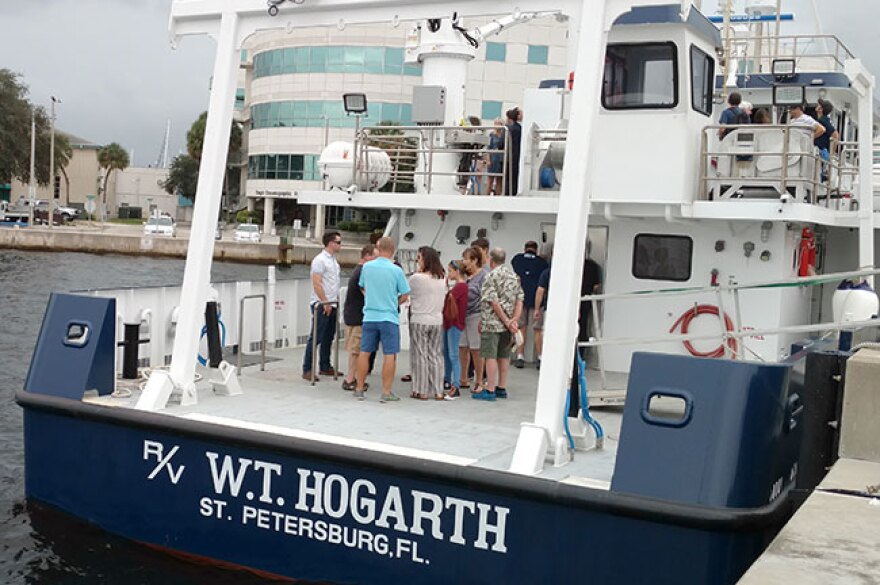When Bill Hogarth was told the Florida Institute of Oceanography's new research vessel was going to be named after him, he had a pretty reasonable - and funny - reaction.
“I said, ‘Somebody knows something I don’t know!’ I think, it’s (the naming) usually after you’re dead, I said, ‘I’m retired but I didn’t know I was dying at the same time!’”
The former institute director and one-time dean of the USF College of Marine – who is not dying – was among the first passengers on the R/V W.T. Hogarth as the state-of-the-art, 78-foot-long ship recently moved into its home port at the University of South Florida St. Petersburg on a recent wet and windy afternoon.
"It’s very hard to put into words, but knowing how much the students use this vessel, how much research is done with this vessel, makes you awfully proud to see your name on it and to know what it will be used for," said Hogarth.
The new craft replaces the almost fifty-year-old Bellows, which is beginning to show its age – in addition to the ship’s sanitation system no longer working, there are concerns about its seaworthiness.
Phillip Kramer, who succeeded Hogarth as institute director, said the new ship gives them one of the largest academic research fleets in the country.
While the Hogarth can be used for three to seven day trips, their larger ship, the 115-foot Weatherbird II, can be used for voyages like the 45-day circumnavigation of the Gulf of Mexico it undertook in 2016.
“And so by having both vessels, it allows us to continue to support some more of the local coastal research and education needs, while we use the larger vessel to support some of the longer-term, larger scale expedition-type research efforts that might take us to places like Cuba and the Bahamas for example," said Kramer.
"We're surrounded by water. We have hurricanes, we have red tide, we have oil spills...that affects our livelihood, tourism and everything."
Speaking of long trips, the Hogarth’s relatively short history has been an odyssey in and of itself.
In 2015, Gov. Rick Scott vetoed $6 million in funding that state legislators had approved.
Hogarth said that forced the almost 30 members of the institute, along with other interested parties, to come together to raise $3 million that the state then matched.
“Universities came forward and FIO, we tightened our belts so we could give a million dollars of it and the city of St. Petersburg contributed,” said Hogarth.
St. Pete’s money came from funds the city received as a result of the 2010 BP oil spill. According to Hogarth, research into things that happen in the Gulf of Mexico – like that disaster – is exactly why a research vessel is necessary.
“Look at us, we’re surrounded by water. We have hurricanes, we have red tide, we have oil spills, just name it," said Hogarth. "That affects our livelihood, tourism and everything.”
At the same time, the boat can also be used to train future marine scientists.
Kramer said that the institute's 12 university members, including USF and Eckerd College, will get about a hundred days every year to give their students the opportunity to learn at sea.
“So we estimate that a lot of the students that spend time on our vessels or down at our labs end up proceeding onto careers in marine science and graduate school or become professionals," he said. "So for us, for many of our members, that sort of hands-on experience can be transformative in their trajectory as students.”

We climbed aboard the Hogarth for a brief tour and cruise. The ship lives up to its billing as a “floating laboratory,” as Marine Operations Officer Rob Walker showed off separate dry and wet labs where scientific parties of up to ten researchers can work.
“We’re going to have biologists onboard, so we could do fish-cleaning here at the wet lab stations. We’ll have chemical oceanographers onboard, we have a fume hood, kind of a chemistry area," he said. "We’ve got a lot of dry lab space for electronics equipment if we’re doing mapping, we may have electronics and different navigation systems stacked from the deck all the way to the overhead.”
And Kramer added that the ship is packed with $1.5 million worth of high-tech systems and other scientific equipment that takes researchers into new territory.
“Dual head multibeam mapping system for imaging the seafloor at resolutions we’ve never been able to do. It will also have remotely operated vehicles for going down off the edge of the reef sometimes it can go up to 500 meters down and really look and take samples,” said Kramer.
In addition, almost every room, has a monitor in it, including the galley, which can double as a science classroom.
“The vessel’s completely networked so all the cabins have network capability and it’s all tied into the data systems that we have in the electronics lab,” said Walker.

The tour also took us to the bridge, where Capt. David Coy guided the ship around Bayboro Harbor with relative ease.
"Efficient motors, powerful motors," he said, comparing the Hogarth to the Bellows. "This is 1200 horsepower versus 400 horsepower, and it doesn’t roll like the old boat did. We brought it down from Tarpon Springs and we had a 20 knot wind, east wind, we had a beam sea coming right at us and it just cut right through it and barely even moved.”
The ship was built by Tarpon Springs-based Duckworth Steel Boats. While Kramer said it’s the first research vessel the company ever built, they brought it in on time and on budget.
“It’s a dream ship for my mind, brand new, it has that clean, new boat smell and it’s been really designed from the ground up with research in mind, so the layout is designed to sort of optimize the way scientists and students typically use a boat,” he said.






